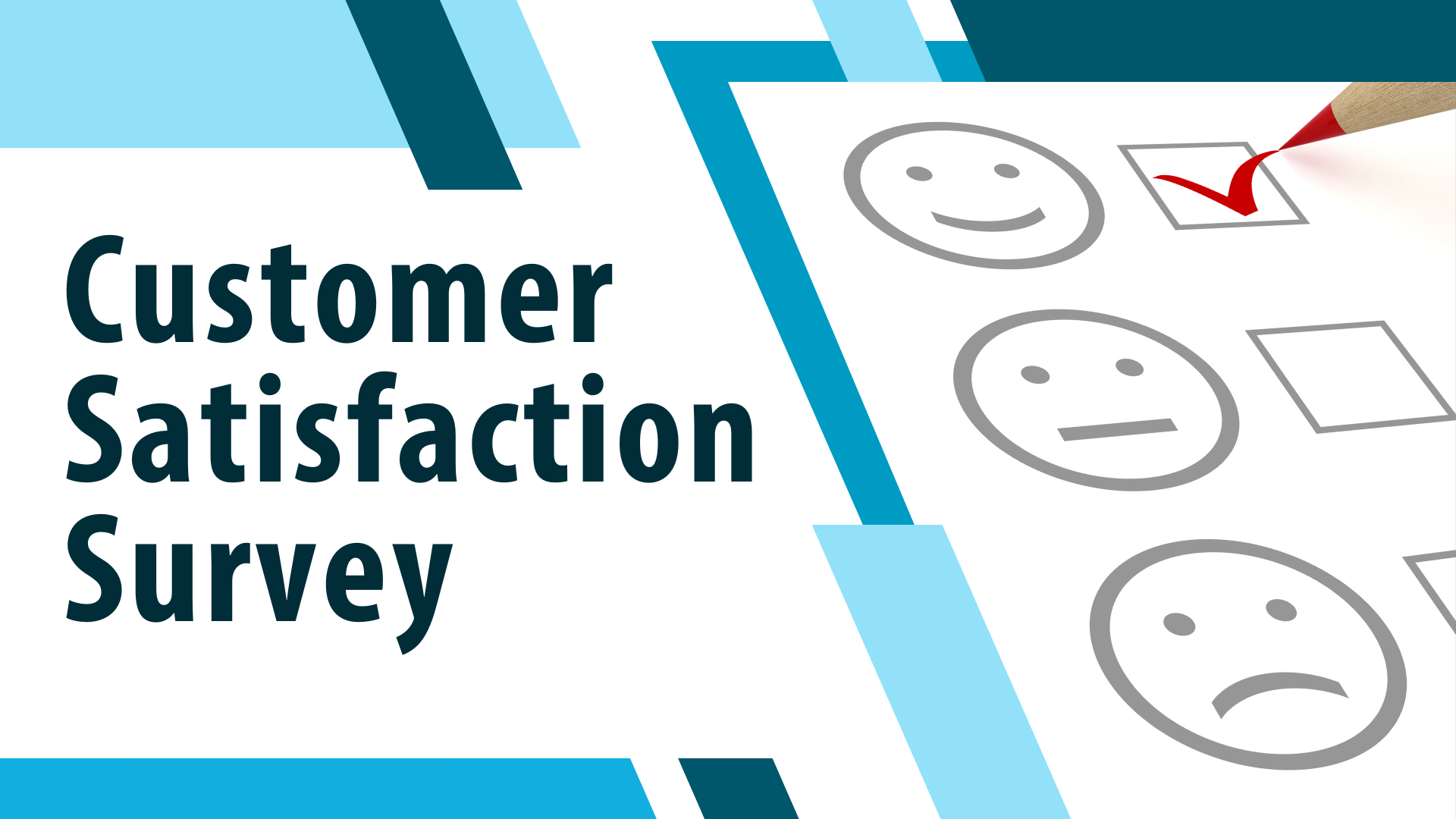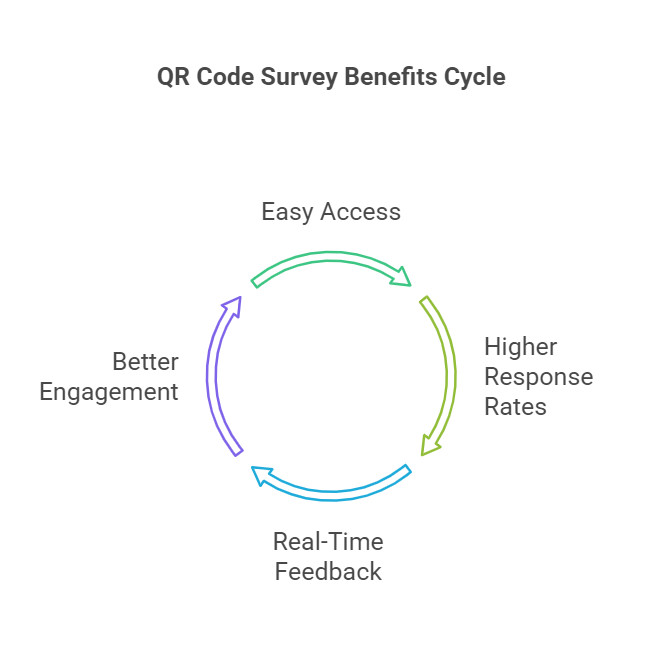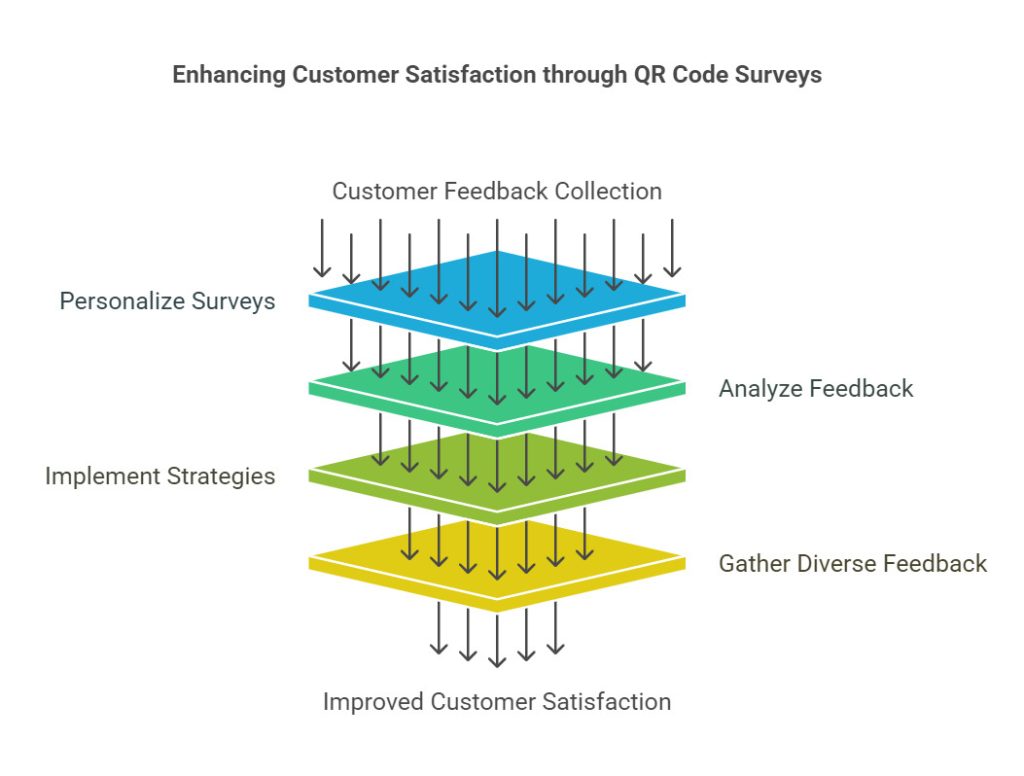- Research platform
Sources of information
Data analysis
Actions
- Solutions
For whom
Problems / Issues
- Materials
Materials
- About us
About us

In the fast-paced digital world now, it’s easier than ever to run a customer satisfaction survey. QR codes are innovative and they simplify feedback. In this blog post, we discuss how to implement QR codes for customer satisfaction surveys, including the use of a customer feedback survey to gather insights. This includes insights, benefits and uses.
Integrating QR codes into customer satisfaction survey strategies is a smart move. It helps customers share their experiences easily. This leads to improved service too. We’ll go through everything from basics to best practices for higher participation in the surveys. Whether one is a business owner wanting better customer understanding or a marketer using tech for surveys, this post guides on using QR codes to gather feedback effectively. Prepare for a new way of collecting customer insights!
QR code surveys serve as an effective method for gathering customer feedback. They make use of quick response (QR) codes that users can scan with a smartphone camera. This directs them to an online survey where they can provide feedback on products or services. This approach is useful for collecting data about customer satisfaction surveys, including Customer Satisfaction Score (CSAT) and Net Promoter Score (NPS). Businesses, in turn, gain important insights.
One key benefit of QR code surveys is that they enhance engagement. Compared to traditional surveys, they allow quicker responses. Scanning a QR code is fast and simple. Customers can offer feedback right away. For example, businesses might place QR codes on receipts and products or even kiosks in stores, encouraging immediate replies while experiences are still recent.
A QR code questionnaire is a modern means of conducting surveys where users can scan a QR code to access the questionnaire directly on their mobile devices. This method offers convenience and immediate access compared to traditional methods like emails or texts, making it effective in collecting feedback and insights.
QR code surveys can look different. They can be brief one-question forms, longer questionnaires, or interactive tools that solicit detailed customer feedback. For example, a CSAT survey could ask clients to rate their experience on a scale, while an NPS survey might ask how likely they are to recommend the business, all facilitated easily with QR codes.
To scan QR codes, a qr code reader app is necessary for decoding the information contained within the QR codes, highlighting its role in accessing various types of encoded data.
When put next to standard survey approaches, QR code surveys often produce much higher response rates. Research shows QR code surveys can yield responses that are up to 30% higher than paper-based surveys. This boost in responses plays a key role in understanding customer opinions and preferences. It is important in today’s busy market.
As companies shift in this digital age, using QR codes in feedback helps them capture real-time insights. This strategy not only makes the feedback process easier but also engages customers more fully. This efficiency gives firms a better chance to connect with their audience.
Shifting away from just basics of QR code surveys, it is vital to look at the advantages these tools present to customer satisfaction surveys. By identifying their benefits, businesses understand how to use QR codes in their feedback systems effectively.

Using QR codes in customer surveys can significantly improve the customer service experience by simplifying feedback collection. One of the main advantages is their ease of access—existing customers can quickly scan the QR code image with their mobile phones, instantly reaching an online survey form. Additionally, unlike standard survey links, QR code surveys can be designed to be anonymous, encouraging respondents to provide honest feedback without concerns about privacy.
Another important benefit is the increased survey completion rate. QR codes offer a quick scan process, making it much easier for customers to give their opinions compared to traditional printed materials or regular online surveys. Studies indicate that response rates for quick response code surveys are often up to 30% higher, largely due to their user-friendly and accessible nature. This allows businesses to quickly capture valuable feedback from their target audience.
QR codes also offer real-time tracking of responses, significantly enhancing data collection and analysis. Businesses can immediately assess customer feedback regarding service quality right after interactions. For example, when a customer scans a QR code following a restaurant visit, the business can instantly evaluate their satisfaction and rapidly address any concerns.
Additionally, QR codes strengthen marketing strategies by effectively connecting physical and digital worlds. They can be strategically placed on receipts, product packaging, or service counters, seamlessly integrating surveys into daily customer interactions. Using tools such as QR Tiger or another third-party QR code survey generator makes it easy for businesses to create and deploy these surveys, efficiently collecting and tracking responses.
In summary, utilizing QR codes in customer satisfaction surveys provides simplified access, boosts response rates, offers real-time insights, and enhances customer engagement. This interactive approach significantly strengthens marketing efforts and helps companies continually enhance their customer service quality.
QR code surveys are a versatile tool for collecting feedback from customers, employees, and other stakeholders. They can be tailored to gather specific information and achieve different goals, making them an invaluable asset for businesses looking to improve their services and products. Here are several types of QR code surveys that can be used to collect valuable feedback:
Customer satisfaction surveys are designed to measure how satisfied customers are with a product, service, or experience. These surveys typically ask questions about the customer’s experience, such as how likely they are to recommend the product or service to others, and how satisfied they are with the quality of the product or service. By using QR codes, businesses can make it easy for customers to provide their feedback on the spot, ensuring that the feedback is timely and relevant. This helps businesses measure customer satisfaction accurately and make necessary improvements.
Net Promoter Score (NPS) surveys are a popular method for measuring customer loyalty and satisfaction. These surveys ask one simple question: “On a scale of 0-10, how likely are you to recommend our product or service to a friend or colleague?” The responses are then categorized into three groups: promoters (9-10), passives (7-8), and detractors (0-6). By using QR codes, businesses can quickly and easily collect NPS data, allowing them to gauge customer loyalty and identify areas for improvement.
Event surveys are used to collect feedback from attendees at events such as conferences, trade shows, and festivals. These surveys can gather information about the attendee’s experience, such as the quality of the speakers, the venue, and the overall organization of the event. By placing QR codes at strategic locations throughout the event, organizers can encourage attendees to provide real-time feedback, helping them to make immediate improvements and enhance future events.
Suggestions and improvements surveys are designed to collect feedback from customers and employees about how to improve a product, service, or process. These surveys can gather ideas for new products or services, or identify areas for improvement in existing ones. By using QR codes, businesses can make it easy for customers and employees to share their suggestions, ensuring that valuable insights are captured and acted upon.
Employee-focused feedback surveys are used to collect feedback from employees about their experience working for a company. These surveys can gather information about employee satisfaction, engagement, and retention, as well as identify areas for improvement in the workplace. By using QR codes, businesses can make it easy for employees to provide their feedback anonymously, ensuring that honest and valuable insights are collected.
By using QR code surveys, businesses can collect feedback from customers and employees in a convenient and efficient way. QR code surveys can be used to measure customer satisfaction, gather suggestions for improvement, and collect feedback from employees. By leveraging QR code surveys, businesses can make data-driven decisions and improve their products, services, and overall customer experience.
Gathering feedback through a customer satisfaction survey using a QR code makes it easier for customers to provide their thoughts. This will help you get more responses. Below are steps to create and use a QR code for that purpose.
Start by knowing what you want to learn from the survey. Are you measuring customer satisfaction, judging a product, or checking service feedback? Being clear helps you write better questions. This way you get useful insights.
Pick a platform that helps you create and share your survey easily. Look for those that have mobile-friendly options. It must be easy for users to reach the customer satisfaction survey with the QR code. A good platform also gives you tools to analyze the data.
Find a trustworthy QR code maker to get your code. Put in the URL for your customer satisfaction survey to make it easy to open on phones. Many code makers also let you customize how it looks, so it aligns well with your brand and is nice to see. A QR code generator simplifies this process by allowing you to create and customize QR codes effortlessly.
After you have the QR code, make it unique by adding colors or your logo. Before using it widely, you must test it with different devices to guarantee that it guides users correctly to your survey. Proper tests lessen any issues users face and boost participation chances. QR code generators often offer features like design personalization and analytics tracking, which are crucial for effective customer engagement.
Put the QR code in spots where customers can easily scan it. This might be on receipts, thank you emails, social media entries, or even on product packaging. Use bright prompts to make them want to scan it, such as offering prizes for taking part in the survey or showing that their feedback matters.
Following these steps allows businesses to set up a QR code that boosts involvement in customer satisfaction surveys. This leads to valuable insights that help refine customer experience.
As you roll out your QR codes, think about the best methods to enhance participation in your customer satisfaction survey and make sure you connect better with customers.
To increase participation in customer satisfaction surveys using QR codes, strategies must enhance user experience and engagement. Here are some best practices to improve your survey design and deployment.
Start by providing clear instructions for scanning QR codes. Users might not know QR codes well or might be confused about how to use them. Step-by-step guidance improves the experience and can lead to higher participation in customer satisfaction surveys.
Another key aspect is mobile-friendliness. Many access customer satisfaction surveys via smartphones. Thus, it is crucial that your survey is easy to use. A responsive layout helps users navigate smoothly on smaller screens.
Next, create visually appealing QR codes. A well-designed and branded QR code stands out. Customizing by using logos and colors invites users to engage. Attractive codes are usually scanned more often, enhancing participation.
Incentives drive engagement. When you provide rewards, like discounts or freebies, customers might be motivated to share feedback. Research shows that surveys with incentives witness notably higher participation rates. Such strategies help gather valuable insights.
Consider where you place QR codes carefully. Positioning them in busy areas, such as checkout lines or on product packaging, makes them more visible. Convenient placement reminds customers to give feedback, which is essential for customer satisfaction surveys.
By implementing these best practices, businesses improve their feedback collection through customer satisfaction surveys using QR codes. This leads to richer insights and a stronger understanding of client needs. Happy customers often result from focused efforts to gather feedback effectively.

QR code surveys boost customer satisfaction survey by connecting customer feedback and data into your business plan. QR surveys are versatile and effective tools for gathering customer feedback, offering innovative approaches to engage participants better. Here are ways to use these surveys for lasting effects on your customers:
By applying these methods, businesses enhance customer experience leading to better customer satisfaction and loyalty. Engaging customers well encourages feedback and builds a strong bond between consumers and your brand.
After improving customer experience, it is important to look into scenarios where QR code surveys can work well. Knowing common situations will help businesses utilize these surveys for good feedback collection.
Customer satisfaction surveys using QR codes are very effective in collecting customer feedback across different industries. Their usage covers various scenarios where instant input can boost information gathering:
Restaurants can benefit from QR code surveys. By placing codes on menus or tables, customers can share thoughts on their meals and service. This real-time feedback improves the dining experience for everyone. Customers can use a qr code scanner, such as Google Lens or their camera app, to easily access the survey.
Retail environments utilize customers satisfaction surveys via QR codes at checkout or in-store. This method helps to gauge how satisfied customers are with products and services. Understanding preferences lets retailers adjust offerings rapidly.
Events also make use of QR code surveys. These surveys provide immediate feedback from guests at concerts, conferences, or festivals. Feedback on food, seating, or activities can drive future improvements and refine overall attendee satisfaction.
In healthcare, facilities are starting to use customer satisfaction surveys through QR codes for patient input. By putting codes in waiting areas or on exit papers, hospitals learn about patient experiences swiftly, enabling them to enhance care quality. A survey's qr code can be strategically placed at the cashier or front door to encourage patient feedback.
Implementing QR code customer satisfaction surveys helps industries quickly gain useful data. This responsiveness to insights can lead to specific improvements and increase overall satisfaction levels. Quick data access save time and helps agencies to meet client expectations.
QR codes give a new way to get customer satisfaction survey results. They make it easier to increase participation and streamline the survey. Businesses that use this method can gain important feedback. The tips for creating and improving these survey codes will help with user satisfaction and gathering info.
Now is a perfect time to apply what you’ve learned. Begin designing a customer satisfaction survey with QR codes. See how they can change the way you interact with your customers. Remember, feedback is key for knowing what customers want and making their experience better.
This method is innovative. Many companies are already using customer satisfaction surveys through QR codes to their advantage. Acting now will boost your survey response rates and build stronger ties to your clientele.
Copyright © 2023. YourCX. All rights reserved — Design by Proformat